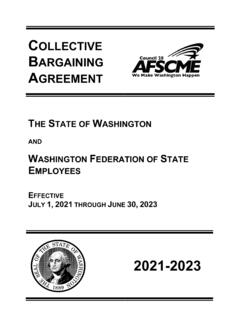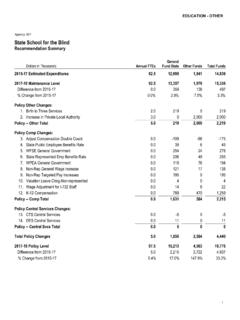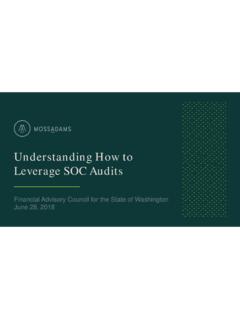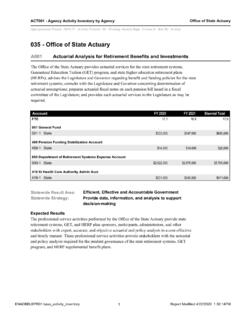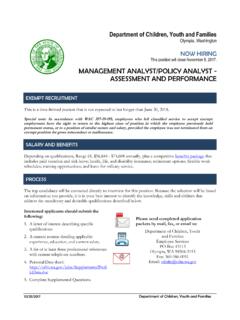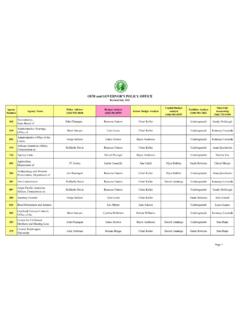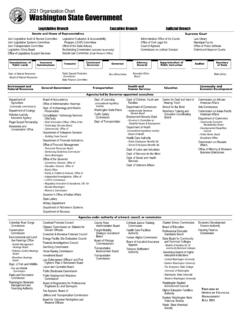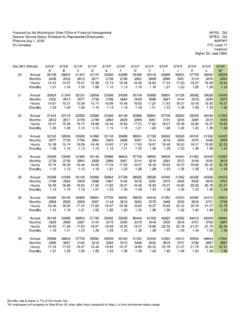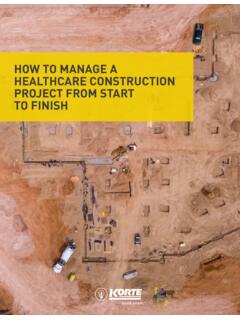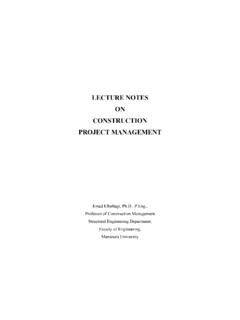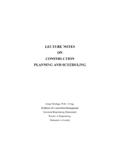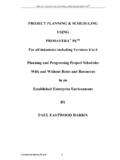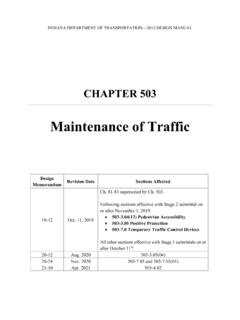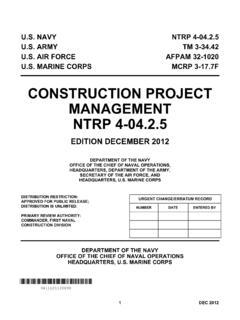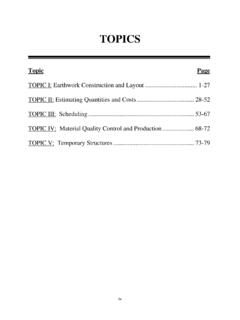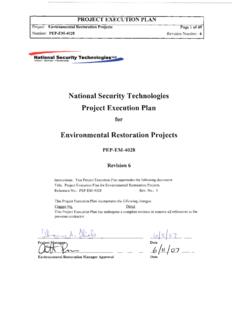Transcription of Architect/Engineer Fees Guidelines for Public Works ...
1 Guidelines for Determining Architect/Engineer Fees for Public Works Building Projects (effective July 1, 2015) When budgeting for state capital projects, the estimated value of the Architectural/Engineering (A/E) Basic Services fee (Exhibit A) can be determined by using these fee Guidelines . The Guidelines are divided into three levels determined by the type and complexity of the building. They are used in the preparation of capital budget requests for Washington State Public Works building projects under the jurisdiction of the Department of Enterprise Services, universities, natural resource agencies, and the Department of Transportation. A/E Basic Services are defined in this document. The payment of A/E fees represents some of the most important dollars spent on a project . These funds are an investment affecting both the quality and successful completion of a project .
2 Recognizing this, calculation of a fee structure to obtain quality design at a reasonable cost presents a challenge. There are pros and cons associated with any system used to set fees, and there is great variation in the types and complexity of state construction projects. These fee Guidelines originally were the outcome of a study coordinated by the Office of Financial Management (OFM) to review other fee Guidelines and identify approaches used by other states. The study included state agencies, the Washington Council of the American Institute of Architects, American Council of Engineering Companies of Washington, and state universities. S tate agencies documented examples within state government where the existing fee system posed problems, and they proposed changes that would improve the state system. Higher education agencies provided evaluations of the scope, magnitude, and methods used to establish fees for design services at peer institutions.
3 Updates to the fee Guidelines also have considered issues raised by the design community. Use of the Guidelines These fee Guidelines should be used in preparing capital budget requests to determine the maximum amount that may be payable for A/E basic service fees in fixed price agreements and percent of construction cost agreements. The Guidelines define the standard basic services (based on the definition of basic services) that should be included in each design phase of state Public Works projects for the typical design/bid/build process. They also provide further definition of what are considered reimbursable expenses, extra and other services. Agencies may choose to pay design consultant fees or allow extra and other charges in a manner other than described in these Guidelines , and any additional cost (above the level provided by the Guidelines ) may be paid from other agency resources.
4 Percent Fee Compensation The standard fee schedule has been prepared to establish a basis for determining the scope and cost of design services and to focus the attention of agencies on the quality, capability, and prior performance of the firms being selected for Public Works projects. The fee schedule is used to prepare capital budget requests. The actual contracts for basic services payable to the A/E shall be a negotiated fixed amount or percentage of the maximum allowable construction cost of the project not including fees; licenses; permits; sales taxes; contingencies; and change orders caused by A/E errors or omissions, or change orders which do not require design consultant services. Based on the specific circumstances of each project , the final negotiated fee may be above or below the Guidelines shown on the schedule. In addition to the basic services fee, allowances will be negotiated for services not covered in the basic services contract.
5 Guidelines for Determining Architect/Engineering Fees for Public Works Building Projects Office of Financial Management 2 March 2015 Maximum Allowable construction Cost The Maximum Allowable construction Cost (MACC) is defined as the total sum available to the general contractor for construction purposes, including all alternates. The MACC excludes Washington state sales tax, professional fees, project contingency funds, or other charges that may not be under the scope of the g eneral contractor. The budget for A/E basic services is based on the MACC plus construction contingency as reflected in the Capital Budgeting System (CBS) and the updated cost estimating form (C -100). The negotiated fee for A/E basic services should be based on the MACC only as shown in Exhibit A A/E Fee Schedule. Remodel Design A/E costs and effort may vary greatly between individual remodeling projects of the same dollar amount.
6 Consequently, each project will be analyzed on an individual basis. As a general rule, the fee will be based upon the building type classification. When program changes are significant or if warranted by other conditions, fees noted under those schedules may be increased by up to three percent for basic services. F actors to be considered include: Age and character of the building Availability and accuracy of existing plans and specifications Extent and type of program revisions Requirement to maintain the building's existing character Extent of mechanical and electrical involvement Phased construction in occupied buildings may substantially affect the construction schedule. More field observation and coordination may require consideration of additional fees beyond the basic services contract amount. Fee Modifications It is recognized that there may be considerable variance between projects of a similar size and type that may necessitate modification of the A/E fee schedule.
7 Examples of special circumstances that may necessitate such modifications include: Unusual site conditions Unique problems requiring specialized or extensive consulting services Renovations required by additions to an existing structure Unusually slow or fast development schedule (fast track, design build, GC/CM) Contractor design (fire protection systems) Large portions of work outside the control of the prime architect (wetlands mitigation) Other circumstances where a fee modification may be appropriate include the following: Repetitive Design Where all or part of a project is a site adaptation of a previous design, the basic services fee shall be negotiated, recognizing the reduced level of services. This usually reduces the program analysis, design, and bidding document preparation costs to an amount necessary to update the documents for site work, code revisions, etc.
8 Reductions must be considered on a case-by-case basis. Guidelines for Determining Architect/Engineering Fees for Public Works Building Projects Office of Financial Management 3 March 2015 Equipment and Substantially Reduced Work Requirements Where a project involves a substantial amount of expensive equipment that may be relatively easy to accommodate, fees should be reduced accordingly. Likewise, any contract or modification to a contract where work requirements are substantially less than indicated by the application of a percentage fee need to be addressed separately. Projects with disproportionate elements of high cost, such as earth moving, may be relatively easy to design and fees should be reduced accordingly. Prototype Design The initial design of a prototype facility, such as a housing unit at an institution, may warrant a full design fee based on the previous development of the prototype.
9 However, the fee for A/E basic services for all additional replications of the prototype constructed at the same time or at other locations in the future shall be calculated at 40 percent of full fees. Policy Regarding Geographic Location of Consultant It is the state s policy to obtain the highest quality design services for a fair and equitable payment to the design firm. The state recognizes that the investment for quality design services is directly related to a well-organized construction process and maximum functionality of the completed project . With this in mind, proposals for design services will be accepted from all firms wishing to work for the state, and evaluated based on the firm's capability, competency, and experience in successfully completing similar projects. The fee structure should be appropriate for each project , regardless of the location of the consultant.
10 The basic services fee includes all travel costs associated with the performance of basic services within a 50-mile radius of the project . General expenses for the cost of travel and per diem between 50 and 350 miles shall be based on state rates and may be reimbursable to the extent they are reasonable and negotiated within the A/E agreement. Travel expenses beyond 350 miles for both the agency and consultants must be justified in writing when submitting a budget request to OFM. Basic Services Fee Breakdown The following is a guide for splitting the A/E fee into approximate percentages for each phase of work. Although it is not intended to be absolute, significant deviations should be closely reviewed. The intent of the Guidelines is to ensure that design requirements progress in an orderly manner and that essential planning and system development occur when most beneficial to the project .
